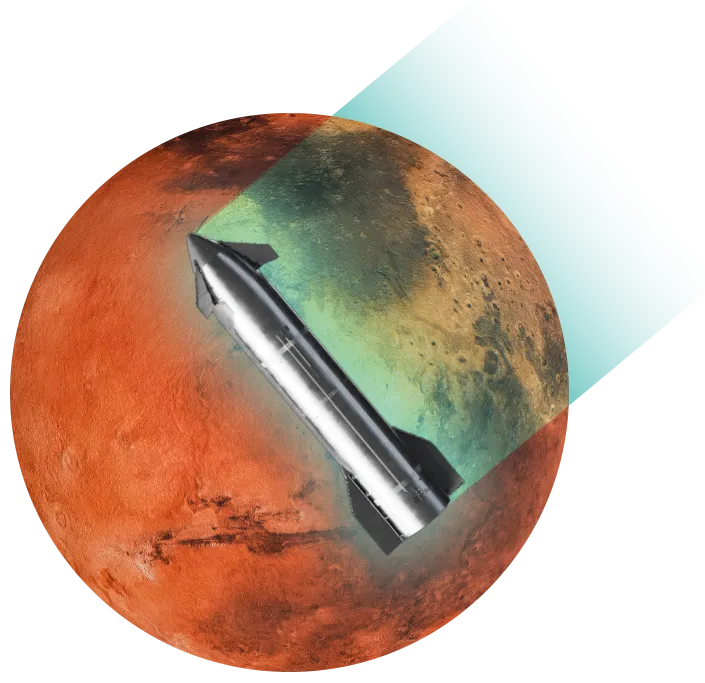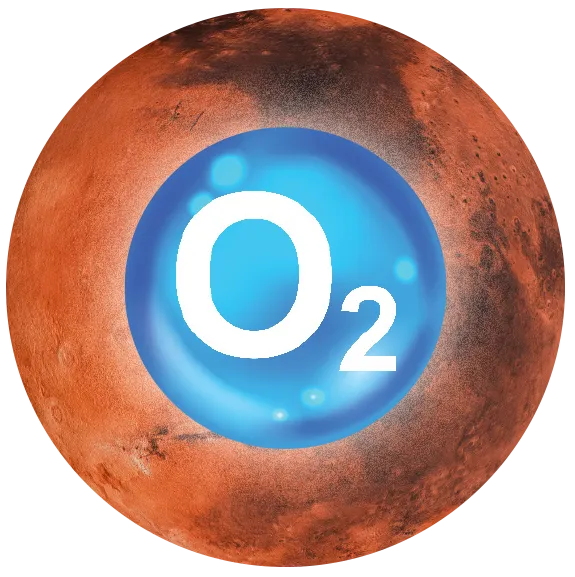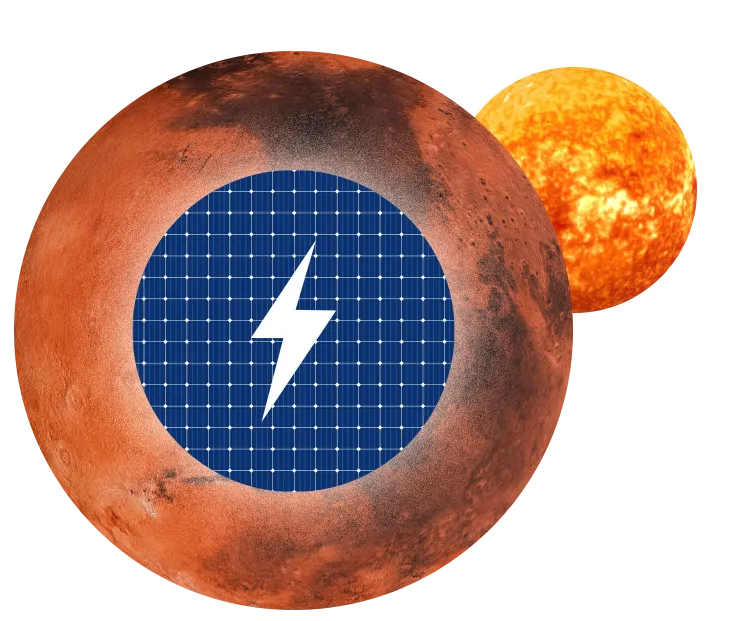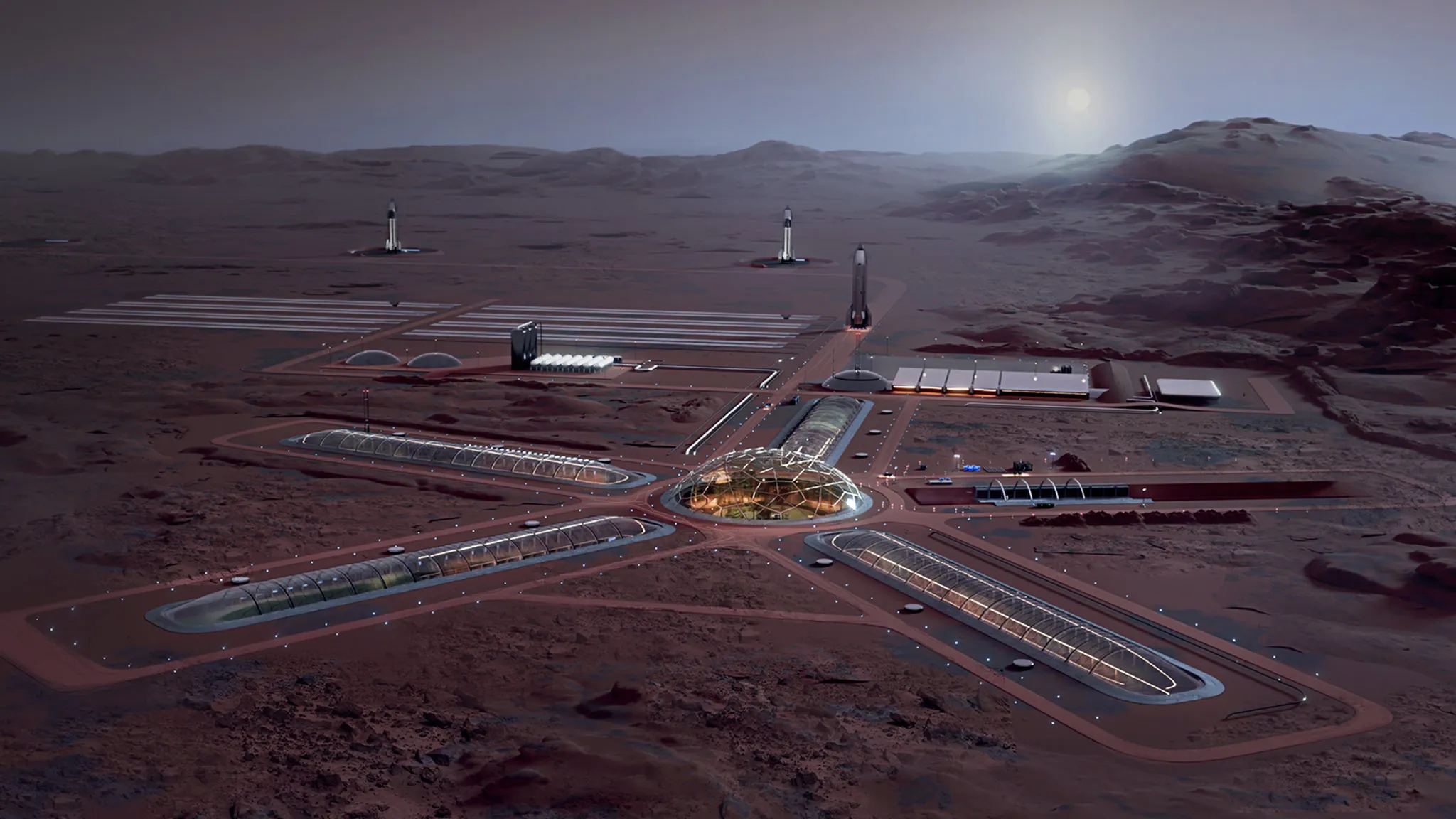Stay Up to Date
Submit your email address to receive the latest industry and Aerospace America news.

Despite meeting all objectives of the 10th Starship test in August, SpaceX’s goal of sending the first Starships toward Mars this decade may still be out of reach. Jon Kelvey examines the proposed plan and the required technologies.
By Jon Kelvey
Over the years, Elon Musk has continually revised his aspirational targets for SpaceX landing an unoccupied craft on the surface of Mars. In a 2016 talk before the International Astronautical Congress, he proposed landing a variant of SpaceX’s Dragon capsule by 2018, only to shift a year later and suggest the still-nascent Starship could touch down on the red planet in 2022.
“I feel fairly confident that we can complete the ship and be ready for a launch in about five years,” he told 2017 IAC attendees, which could have paved the way for landing two crewed Starships on Mars by 2024.
He shifted that target yet again in May, during a talk at SpaceX’s Starbase facility in Texas. But this time he gave more details, describing the broad outlines of a step-by-step approach for landing the first humans as soon as 2029.
Five uncrewed Starships would lift off in 2026, the next time the orbits of Earth and Mars are aligned. If all goes well, the craft would touch down on Mars in 2027, carrying an unspecified number of the bipedal Optimus robot made by Musk’s electric car company, Tesla. Another 20 Starships would lift off during the next transfer window in 2028. Most of them would carry additional Optimuses to set up Martian ground infrastructure and survey for resources, such as water ice, but at least one of the Starships would carry an unspecified number of human passengers.
I like it. I like it a lot. He's checking all the boxes here that I would like to see checked.
— Robert Moses, retired aerospace engineer from NASA's Langley Research Center
Plans then call for steadily increasing the number of flights every 26 months, in each subsequent launch opportunity: 100 Starships in 2031, 500 in 2033, working up to the eventual target of “1,000 or 2,000 ships per Mars rendezvous,” Musk said, with each crewed Starship carrying 100 to 200 passengers.
The general plan is sound, according to the 10 experts I spoke with for this piece, several of whom were retired NASA employees who oversaw previous Mars missions and contributed to the agency’s plans for sending its own astronauts to the red planet.
“I like it. I like it a lot,” says Robert Moses, a retired aerospace engineer from NASA’s Langley Research Center in Virginia. Like many I spoke with, Moses compared the SpaceX architecture favorably to NASA’s latest reference mission, though SpaceX’s plan includes hundreds more spacecraft and crew. “He’s checking all the boxes here that I would like to see checked.”
What’s less certain is whether SpaceX can stick to the launch targets. Even Musk acknowledges that 2026 is ambitious, tweeting in early August that it was “more likely” the first uncrewed Starships would launch “in ~3.5 years, next flight ~5.5 years with humans.”
That might be OK, Moses says, since pushing the first uncrewed missions to 2028 “still gives him one more opportunity before 2033 to throw everything possible over to Mars.”
But perhaps of greatest concern to Moses and the other experts are the numerous technical challenges SpaceX still needs to address — many of which have never been demonstrated by any organization — to ensure a successful Mars transit and surface operations, any of which could turn into a mission-swallowing morass. My emails to SpaceX requesting comment went unanswered, so for this report I drew on public documents and remarks by Musk and other executives describing the Mars plan.
For SpaceX’s plan to work, the behemoth Starship-Super Heavy design must reach orbit as reliably as the company’s Falcon 9 workhorse, which in September logged its 500th flight. For both vehicles, SpaceX has touted an iterative design approach in which the designs are incrementally refined between a series of rapid flight tests. But with Starship, SpaceX may have reached the limits of this “build a little, test a little, fail a little” strategy, says Scott Hubbard, former director of NASA’s Ames Research Center and now director emeritus of the Stanford Center of Excellence for Commercial Space Transportation.



Several Starship upper stages have reached orbital altitude but none have escaped Earth's gravity well. SpaceX is targeting 2026 for a “long-duration flight test” in which a Version 3 Starship will “spend an extended time on orbit.”
With Falcon, “there was a distinct improvement from flight to flight, until it’s now 150 flights or something without a problem,” he says. “Starship is nowhere near that at this point.”
Starship has never reached orbit; instead, SpaceX has followed a suborbital trajectory for the 10 integrated flight tests conducted to date, in which the upper stages were sent toward controlled splashdowns in the Indian Ocean. The most recent Starship test, conducted in August, was the first to survive the punishing trek through the atmosphere and splash down intact since late 2024, ending a streak of failures that included three Starships exploding in flight and another exploding on the ground during a June static fire test.
Once Starship reaches Earth orbit, the next challenge will be docking with multiple “tankers” to fill its tanks with the 933 metric tons of liquid oxygen and 267 metric tons of liquid methane required to reach Mars. A full load of propellant is essential for reducing the transit time to three to four months, according to Moses, so as to minimize how long the human crews are exposed to hazardous galactic cosmic radiation.



SpaceX in 2024 transferred 5 metric tons of propellant between two tanks of the same Starship. A full-scale transfer demonstration between two Starships is planned for 2026.
As necessary as it is, that refueling process involves a lot of logistics. “Starship needs 1,200 tons of propellant, and you’ve got a tanker that takes 100 tons at a time,” says Donald Rapp, a chemical engineer and consultant for NASA’s Jet Propulsion Laboratory for the Mars 2020 mission. That works out to 12 tanker launches to fuel each Mars-bound Starship.
By those calculations, the five Starships leaving Earth in 2026 would require 60 tanker launches, says Rapp — ample opportunity to test Murphy’s law, and an unprecedented stress test of ground infrastructure.
That refueling maneuver itself is sound in theory, but there is scant evidence from practice. “There’s been a lot of models that have been developed,” says William Notardonato, a former NASA engineer and now CEO of Eta Space, a Rockledge, Florida, company developing spacecraft for small-scale cryogenic propellant transfers in Earth orbit. But “nobody’s really been able to accurately anchor those models in flight data using a real cryogenic fluid.”
Among the techniques SpaceX has yet to demonstrate is refueling a Starship in Earth orbit. This illustration depicts a lunar lander variant of Starship (left) docking with a “tanker” version carrying liquid oxygen and liquid methane. Courtesy of SpaceX.
SpaceX transferred an undisclosed amount of liquid oxygen between two internal tanks during a 2024 Starship test, but no one has yet attempted large transfer between two spacecraft. SpaceX plans to do so in 2026, per Musk, pitting SpaceX’s iterative design philosophy directly against his ambitious timeline.
Among the factors to be determined in these tests is how much of the cryogenic propellant will evaporate upon first contact with the relatively warm lines and empty tanks, according to Notardonato. These “parasitic” losses pose another challenge for SpaceX: Lose too much, and additional tanker launches could be required to fuel up each Starship.
“You might have to launch one or two more refueling missions,” Notardonato says, “and nobody really knows how many refueling missions they’re going to have to do yet.”
Transit to Mars is just the first step of the journey. Once arriving in orbit, Starship must navigate entry, descent and landing. At 200 tons or more, depending on payload, each Starship will be 200 times more massive than any craft that’s previously touched down, and therefore requires a different landing technique.
NASA spacecraft, including the Perseverance rover, relied on single-use, ablative heat shields to protect them during the searing journey to the surface. By contrast, each Starship will depend on a reusable heat shield made of hexagonal metallic-ceramic tiles for aerobraking in the Martian atmosphere, using friction to slow from 7.5 kilometers per second to around 1 kilometer per second.



SpaceX conducted tunnel tests with samples of Starship heat shield material in late 2024, and multiple Starship flights have tested various heat shield materials and landing trajectories.
“No one has ever developed a truly reusable orbital heat shield,” Musk said in his May talk. He noted that the thin, carbon dioxide-rich atmosphere of Mars, when ionized by the heat of entry, generates more free oxygen than Earth’s, which will eat away at shield tiles.
For Flight 10, SpaceX technicians installed tiles of various compositions on different parts of the Starship upper stage, and the vehicle’s reentry trajectory was “designed to intentionally stress the structural limits of the rear flaps” that would steer the vehicle through the atmosphere, SpaceX said on its website.
With Falcon, “there was a distinct improvement from flight to flight, until it's now 150 flights or something without a problem” he says. “Starship is nowhere near that at this point”
— Scott Hubbard, former director of NASA's Ames Research Center
Then there’s the landing itself, which Hubbard predicts could pose an even greater challenge due to Starship’s height of 52 meters. There’s a reason, he says, that NASA utilized parachutes and airbag-cushioned landings for many of its landers and rovers, which were relatively squat vehicles with low centers of gravity.
“Landing vertically looks very slick,” Hubbard says, “but look at the failures to land on the moon with a tall, slender vehicle.” He pointed to the Odysseus lander built by Intuitive Machines that “tipped right over” in early 2024 after a laser altimeter failure led it to land faster and on a steeper slope on the lunar surface than anticipated.
“A lower center of gravity would always add stability,” Hubbard told me in a follow-up email, noting that there are no flat, well-prepared landing pads awaiting the first Starships landing on the moon or Mars.

SpaceX in November 2024 shared these photos of a ground test in which Starship heat shield materials were subjected to conditions similar to those the craft would encounter as it plunges through the Martian atmosphere toward the surface. Surviving entry, descent and landing will be a key milestone of the first Starship Mars flight, which SpaceX could conduct as soon as 2026. Courtesy of SpaceX.
Once the first Starships reach Mars, the job of setting up camp for human astronauts will fall to Optimus. The bipedal humanoids are to install power plants and other infrastructure, as well as scout for resources such as water ice. In May, Musk showed an image of Optimus ironworkers building the Empire State Building, sitting on a girder eating lunch.
Hubbard, who in 2000 became NASA’s first Mars Program director, has doubts Optimus can do the job. He notes that many of the demonstration videos show the robots in well-prepared environments — a sharp contrast to the barren Martian surface. Tesla has also been criticized over videos it’s shared of Optimuses seemingly cooking or interacting with people at events, where it later turned out the robots were at least partially remote controlled.



Tesla opened a pilot production line in early 2025, with full-scale production targeted to begin in 2026.
Instead, “Why not take a whole bunch of rovers of a design you’re pretty sure will work?” Hubbard asks. The six-wheel design used for Perseverance and Curiosity has proven “capable of adapting to almost any kind of surface with enough clearance.”
Another option is to take to the air. Optimus is “inferior as an exploration platform to a scaled-up Ingenuity helicopter, which can fly,” says Robert Zubrin, an aerospace engineer and longtime Mars mission optimist, referring to the small rotorcraft that rode along with Perseverance and completed 72 flights in three years.

For the inaugural Starship launches to Mars, the spacecraft will carry Optimus robots, like those shown in this illustration, to set up the infrastructure required for human astronauts to survive on the surface. Courtesy of SpaceX.
Given Starship’s touted 100-metric-ton payload capacity, Zubrin believes that SpaceX could deliver an army of rovers and rotorcraft, “like the troops coming off the landing craft at Normandy Beach,” he says, and conduct more Mars science in two years than NASA has been able to in decades.
Neither Musk’s remarks nor SpaceX’s public materials indicate to what extent science factors into the objectives for the early Mars landings. But Zubrin and other experts agree that if Musk is to achieve the self-sustaining city of his dreams, some form of robotic automation will be essential.
NASA’s planning has long assumed in situ resource utilization will be key to human Mars missions. The latest concept, Design Reference Architecture 5 (DRA-5), calls for pre-positioning solid oxide electrolysis cells on Mars ahead of astronauts’ arrival. Essentially a fuel cell run in reverse, solid oxide electrolysis cells would split atmospheric carbon dioxide into carbon monoxide and oxygen via electric current.



NASA’s MOXIE experiment in 2021 produced 122 grams of oxygen over 30 months via electrolysis.
Operating over 16 months, the electrolysis unit would produce 25 tons of liquid oxygen to power the Mars Ascent Vehicle, along with 6 tons of liquid methane propellant that the astronauts would have brought from Earth. Once fueled, this rocket would return astronauts to Earth at the end of their mission.
NASA in 2021 proved this general concept with the MOXIE experiment aboard the Perseverance rover, which produced 122 grams of oxygen over 30 months. Scaling MOXIE up to make tons of liquid oxygen would not be difficult, according to Michael Hecht, the experiment’s principal investigator, but it wouldn’t come free.
“It takes a lot of energy to pull a carbon dioxide molecule apart,” he says — about a kilowatt per kilogram of oxygen produced.
In NASA’s plan, a nuclear fission reactor would be required to produce the 25 kilowatts of power necessary to create 25 tons of liquid oxygen. By Hecht’s calculations, Starship would need more: roughly 600 kW to produce 600 tons of liquid oxygen for each vehicle returning to Earth, if filled to capacity.
Unlike NASA, SpaceX plans to rely on solar power — “a lot of solar power,” Musk has said, though he hasn’t elaborated on the mechanism for collecting and storing that energy.



Musk says SpaceX will rely on solar power but hasn’t elaborated on how it would be collected and stored.
The technique could work, Hecht says, but again, at a cost: “The solar arrays are going to be more massive, certainly, than the reactors would be,” Hecht says. NASA’s DRA-5 estimated that producing 25 tons of liquid oxygen would require around 1,450 square meters of solar panels, putting the potential SpaceX equivalent at 38,400 square meters — about seven American football fields.
That’s a lot of infrastructure for Optimus to set up and maintain ahead of human crews. But the alternative — sending humans to set things up without already having propellant stored and ready for a return mission — “strikes me as dangerous beyond belief,” Hubbard says.
And unless SpaceX also wants to fly a lot of extra liquid methane to Mars, it will need to utilize a different process than MOXIE to create that methane on Mars, according to Rapp: the Sabatier reaction, which uses electricity and carbon dioxide, but also requires water. The basic premise is to run an electric current through the water to split it into oxygen and hydrogen. Take the hydrogen and react it with carbon dioxide at around 300 degrees Celsius to obtain methane and more water, with the water fed back into the loop.
“It’s a very simple process,” Rapp says, “It’s almost risk free.”
But SpaceX would need to find a lot of water on Mars, he notes, and while orbital data suggests abundant subsurface water may exist, there’s no concrete evidence yet. But let’s assume there is 15% water in Martian regolith, he says, based on a February paper in the journal IgMin Research. That means to create 5 tons of propellants per day, Optimus or some other machinery would need to process 33 tons of surface material.
All that taken together, the odds that a Starship will launch to Mars in 2026 is nearly impossible, Zubrin says. “The notion they’re going to land a Starship on Mars that they launch next year is not true. If you disagree, I’ll bet you $1,000.”
He agrees with Moses that 2028 seems more feasible, but he also warned against waiting too long, lest the Trump administration or Congress change its priorities, causing SpaceX to lose momentum.
“The notion they’re going to land a Starship on Mars that they launch next year is not true. If you disagree, I’ll bet you $1,000.”
— Robert Zubrin, aerospace engineer
“I don’t think Apollo could have been accomplished in a 20-year schedule,” he says. “It had to be accomplished on an eight-year schedule,” or else the political and economic conditions that led then-President Richard Nixon to cancel the program after the Apollo 17 landing could have overtaken the program sooner.
Politics may be the biggest unknown of all when it comes to SpaceX’s plans. Between Musk’s public falling-out with President Donald Trump and the proposed cuts to NASA funding, it’s not clear there’s government support for the public-private, NASA-SpaceX partnership that most experts I spoke with believe is necessary to achieve a human Mars mission.

Elon Musk's ultimate goal is to establish a “self-sustaining” city on Mars, which he predicts could be achieved in "20 to 30 years," according to an August post on X. Courtesy of SpaceX.
“A lot of people take it as a given that it will work, and there’s really no guarantee,” says Casey Dreier, chief of space policy at the Planetary Society, about SpaceX, Starship and Mars. But “you never want to bet against SpaceX as a company, because they are, frankly, incredibly capable.”

Jon Kelvey covered space for The Independent in the U.K. His work has appeared in Air and Space Smithsonian, Slate and The Washington Post. He is based in Maryland.